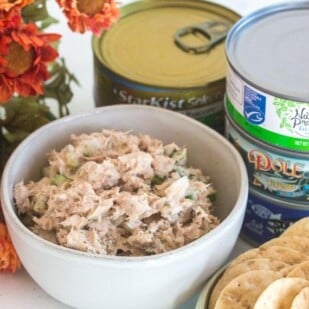Our Low FODMAP Lemon Salad Dressing strikes just the right balance between sharp acidity and fat, with just a little salt and pepper to season. A dab of Dijon mustard helps emulsify the mixture. We love this salad dressing with our Greens with Pomegranate & Kumquats and our Low FODMAP Grated Carrot Salad.
Ingredients For Low FODMAP Lemon Salad Dressing
When you have a recipe with so few ingredients, make sure that every one of them is of the highest quality.
Extra-virgin olive oil – Use an olive oil that you LOVE. One brand from another will vary hugely in flavor. Have a tasting to determine your “house” oil.
Freshly Squeezed Lemon Juice – There are some recipes that use a very small amount of lemon juice and in these instances (like our Low FODMAP Ranch Dressing), a high-quality product like frozen Minute Maid 100% Lemon Juice can be used. I can not recommend any bottled lemon juices. For a recipe like this Low FODMAP Lemon Salad Dressing where lemon is a highlight, you must use freshly squeezed. No exceptions.
I like to juice my lemons with a reamer, as seen below and am not partial to the type that clamp over the lemon and rind. In my opinion, those types produce bitter juice.
Dijon Mustard – Mustard (we like Dijon) adds flavor, body and acts as an emulsifier, meaning it helps bind the water based lemon juice and the oil together, which you can see in images below.
Kosher salt – We use kosher salt for our cooking and fine table salt for our baking. Use kosher salt here; we prefer its flavor.
Freshly ground black pepper – When it comes to pepper, it has to be freshly ground. Period. I use a Peppermate mill and I love it. Very easy to use, even for my arthritic hands.
How To Make Low FODMAP Lemon Salad Dressing
Could it be any easier? You could whisk together in a bowl, but I like to shake everything together in a jar.
Before you shake and add the mustard you will be able to see the oil and lemon juice are separate, as shown below. You know, oil and water (vinegar) don’t mix!
Once you add the mustard, which acts as an emulsifier, and shake like crazy you get a thick bodied Low FODMAP Lemon Salad Dressing.
Emulsification
You know the saying – oil and water don’t mix. In this case we have oil and vinegar, the latter which has water content. The mustard acts as an emulsifier, meaning it helps bring everything together, but sometimes the mixture needs a little help. If you have a little milk frother around the house, use it here! It works like a dream.
These hand-held frothers are battery operated, inexpensive and fun to use. And of course you can use them to make fancy coffee drinks.


Low FODMAP Lemon Salad Dressing
Our Low FODMAP Lemon Salad Dressing strikes just the right balance between sharp acidity and fat, with just a little salt and pepper to season. A dab of Dijon mustard helps emulsify the mixture. We love this salad dressing with our Low FODMAP Grated Carrot Salad.
Low FODMAP Serving Size Info: Makes about ¾ cup; 6 servings; serving size 2 tablespoons
Ingredients:
- ½ cup (120 ml) extra-virgin olive oil
- ¼ cup (60 ml) freshly squeezed lemon juice
- 1 teaspoon Dijon mustard, or coarse mustard
- Kosher salt
- Freshly ground black pepper
Preparation:
-
In a small jar, vigorously shake together the oil, lemon juice and Dijon mustard. Taste and season with salt and pepper. Low FODMAP Lemon Salad Dressing is ready to use or may be refrigerated, in an airtight container, up to 3 days.
-
Bring to room temperature before using and re-shake before dressing your salad.
Notes:
Tips
FODMAP Information
Our recipes are based on Monash University and FODMAP Friendly science.
- Lemon Juice: Monash University has lab tested lemon juice and it is low FODMAP in ½ cup (125 g) amounts.
Please always refer to the Monash University & FODMAP Friendly smartphone apps for the most up-to-date lab tested information. As always, your tolerance is what counts; please eat accordingly. The ultimate goal of the low FODMAP diet is to eat as broadly as possible, without triggering symptoms, for the healthiest microbiome.
Nutrition
All nutritional information is based on third-party calculations and should be considered estimates. Actual nutritional content will vary with brands used, measuring methods, portion sizes and more. For a more detailed explanation, please read our article Understanding The Nutrition Panel Within Our Recipes.













What a great recipe. So Tasty!
I really love this with my salads! Also bonus I discovered it works great if you toss it onto veggies as you sautee!
I do this too! So great to see folks getting creative in the kitchen.